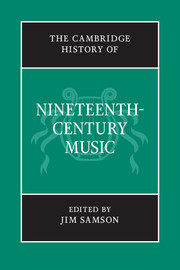Book contents
- Frontmatter
- Part One 1800–1850
- Part Two 1850–1900
- 11 Progress, modernity and the concept of an avant-garde
- 12 Music as ideal: the aesthetics of autonomy
- 13 The structures of musical life
- 14 Opera and music drama
- 15 Beethoven reception: the symphonic tradition
- 16 Words and music in Germany and France
- 17 Chamber music and piano
- 18 Choral culture and the regeneration of the organ
- 19 Music and social class
- 20 Nations and nationalism
- 21 Styles and languages around the turn of the century
- Chronology
- Institutions
- Personalia
- Index
- References
21 - Styles and languages around the turn of the century
from Part Two - 1850–1900
Published online by Cambridge University Press: 28 March 2008
- Frontmatter
- Part One 1800–1850
- Part Two 1850–1900
- 11 Progress, modernity and the concept of an avant-garde
- 12 Music as ideal: the aesthetics of autonomy
- 13 The structures of musical life
- 14 Opera and music drama
- 15 Beethoven reception: the symphonic tradition
- 16 Words and music in Germany and France
- 17 Chamber music and piano
- 18 Choral culture and the regeneration of the organ
- 19 Music and social class
- 20 Nations and nationalism
- 21 Styles and languages around the turn of the century
- Chronology
- Institutions
- Personalia
- Index
- References
Summary
The title of this chapter implies not only a concern with musical style and musical language, but also that a distinction may be drawn between the two. In the paragraphs that follow I shall take this distinction to be roughly equivalent to the point at which the style of a musical passage, work or repertory can be said to be more than simply a matter of how a composer’s musical mannerisms, habits or inclinations are identifiable as an emergent property of the music he or she produces. At this point, ‘style’ – as an attribute of a passage, piece or repertory – becomes something that can be manipulated along with the musical elements that express that style. Such manipulation allows musical language to be deployed as a means to a variety of ends: to express emotion, for example, or to articulate a drama, or to engage in cultural politics.
All of this presupposes that differences of style are actually recognisable as such across the field of contemporaneous musical composition, and indeed by the middle of the nineteenth century this had clearly been the case for some time. What is more, one of the century’s most notable attempts to deploy musical language for culture-political ends dates from this time, with the declaration of the New German School. But the most remarkable flowering of this kind of project was to come a little later, in and around the two decades that straddle the turn of the nineteenth and twentieth centuries. A music-lover of catholic tastes who had the time and resources to travel around Europe and North America taking in premiéres during this period could have heard the first performances of works as diverse as Don Juan(1889), Pagliacci(1892), the Variations on America (1892), En Saga(1893), the Prélude à l’Aprè-midi d’un faune (1894), the ‘Resurrection’ Symphony (1895), Verklärte Nacht(1902), Debussy’s Pelléas et Mélisande (1902), Jenůfa (1904), Salome (1905), the Poem of Ecstasy (1908) and The Firebird (1910) – to name a mere dozen.
- Type
- Chapter
- Information
- The Cambridge History of Nineteenth-Century Music , pp. 601 - 620Publisher: Cambridge University PressPrint publication year: 2001



